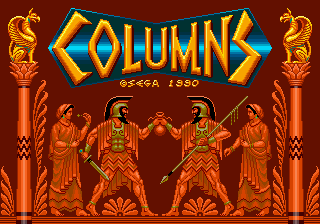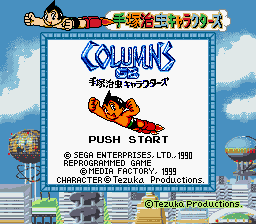Overview
 The first game in the Columns franchise.
The first game in the Columns franchise. The Columns franchise began in 1989 when Jay Geertsen designed it for the X Window System. It was later ported to MS-DOS,
Macintosh,
Windows, and
Atari ST platforms. In 1990, Jay Geertsen sold the rights of Columns to
Sega. Sega then released Columns for the
Sega Genesis on June 30, 1990. Since its original release, the franchise has appeared on a variety of consoles, including the
arcade,
TurboGrafx-16,
Sega Master System,
Game Gear, Sega Genesis,
Sega CD,
Super Famicom,
Game Boy Color,
Game Boy Advance,
Sega Saturn,
PlayStation 2,
Dreamcast,
Virtual Console,
NEC PC-9801,
MSX 2, and
iPhone.
In addition to being available on this wide variety of platforms, the Columns franchise has been made available on several compilation games. Columns was made available on
Sega Ages Vol. 07: Columns for the PlayStation 2 (only in Japan), the Columns Arcade Collection for the Sega Saturn, and the
Hanagumi Taisen Columns (as well as its sequel, Hanagumi Taisen Columns 2, both of which are a combination of the
Sakura Wars and Columns franchises). Columns has been released in several North American releases as well, including both releases of the
Sega Genesis Collection and
Sonic's Ultimate Genesis Collection.
Games
Columns
 The Game Boy Color version stars Tezuka Osamu characters.
The Game Boy Color version stars Tezuka Osamu characters. The first major game in the Columns franchise,
Columns was released in 1990. The game is similar to
Tetris in gameplay style and basic concepts, although there are many drastic differences between Columns and other block dropping puzzle games. In Columns, the goal is to match three off the same color horizontally, vertically, or diagonally. In addition, Columns only has vertically shaped blocks "three part blocks," where the three symbols inside can be flipped around to match them up.
Other versions of Columns were later released, most notably a Game Gear version, a Game Boy Color version titled
Columns GB: Tezuka Osamu Characters, and a 1997 arcade update of the game titled Columns '97. The Game Gear version differed in a few aspects, particularly the music, graphics, and the ability to change exactly what the symbols were inside the blocks. The Game Boy Color version, Columns GB, added several characters that were created by
Tezuka Osamu, including Kimba,
Astro Boy, and Unico. Columns '97 is a largely graphical update to the franchise, and was released only in Japan.
Columns II: The Voyage Through Time
 The title screen for Columns II shows some obvious graphical and stylistic differences.
The title screen for Columns II shows some obvious graphical and stylistic differences. Released in 1990,
Columns II was an arcade exclusive (although it was later ported to the Sega Saturn in the Columns Arcade Collection). Columns II did little to expand on the franchise, only adding a few notable things. The graphical change is notable, particularly evidenced with the pixel art of the game's title screen. Also on a graphical note, Columns II introduced the option to change what background the game had, which has since become a series standard. Beyond these changes, nothing was changed beyond graphical updates.
Columns III: Revenge of Columns
With the release of
Columns III, the franchise was brought back to its console roots. The game was released in 1993 for the Sega Genesis (as well as an arcade version). Despite the naming discrepancy, Columns III actually does very little to differentiate itself from other games in the franchise. The most major thing that Columns III changes is the fact that players are now required to play against an opponent at all times. In addition, Columns III has a separate story mode, it adds new special blocks (which make a certain symbol disappear from the playing field), and the ability to have multiplayer with up to five players simultaneously.
Super Columns
The first handheld exclusive game in the franchise, Super Columns was released in 1995 for the Game Gear. Super Columns is particularly notable for being the pack-in game for the Game Gear. The largest change that Super Columns made to the traditional gameplay is actually one of the biggest changes in the Columns franchise. This game adds the ability to flip blocks horizontally, rather than constricting blocks to constantly stay vertical. Super Columns also has a story in which the player must fight against a corrupt merchant who wants to use a jewel to his advantage.
Columns Crown
 Columns Crown adds power-ups and versus play.
Columns Crown adds power-ups and versus play. The most recent release in the Columns franchise,
Columns Crown was released on December 13, 2001 in North America for the Game Boy Advance. The game is a loose remake of Super Columns, expanding the story, upgrading the graphics, and adding certain gameplay elements. Columns Crown adds the ability to use power-ups, which can either be an offensive or defensive ability. For example, Quake will shake the opponent's screen and Freeze will stop the blocks on the opponent's screen. In addition to power-ups, Columns Crown adds the ability to play versus games over the Game Boy Advance Link Cable in both single and multi-cartridge play.
Log in to comment